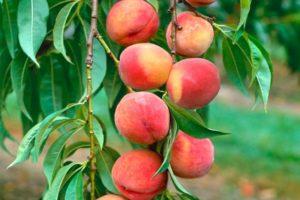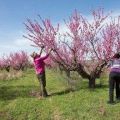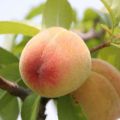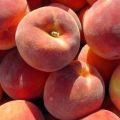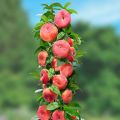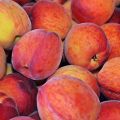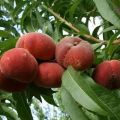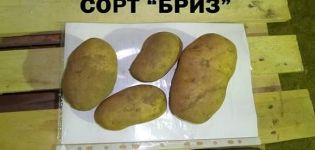Description and characteristics of the Ambassador of Peace peach variety, planting and care
Peach has earned the reputation of being a capricious plant. Gardeners are afraid to plant it in their plots due to the defeat of the culture by diseases and pests, the frequency of fruiting, fear of frost. But there is a variety of unpretentious, high-yielding, frost-resistant enough. This peach is called - Ambassador of Peace. Further information on the pros and cons of the variety, growing, caring for, protecting it from diseases and pests, as well as the rules for harvesting and storing crops.
Varietal features of the fruit tree
The ambassador of peace reaches a height of 5-6 meters, the crown forms a rounded, spreading. The green leaves are lanceolate, the pink flowers are bell-shaped. The variety is self-fertile; it does not require pollinators.
Fruit weight varies between 180-200 grams. The peel is yellow with carmine blotches, the pulp is yellow, juicy, with a delicate fibrous structure. The fruits are tasty, aromatic, the sugar content in them reaches 12.1%. The stone is easily separated from the fruit.
Pros and Cons of Peach Peace Ambassador
The advantages of the variety include the following qualities:
- high productivity;
- excellent taste characteristics of the fruit;
- stable fruiting;
- fruits tolerate transportation well;
- resistance to low temperatures;
- strong immunity;
- universal use of fruits.
The disadvantages of the variety include fragility of the branches. This happens when there is an abundance of fruits on them, so you need to constantly make standardized pruning.
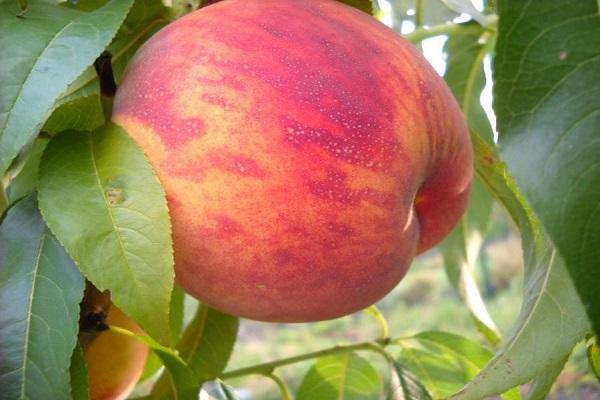
The subtleties of growing varieties
Stone fruits bear fruit early, so it is very important to plant them at the right time. Also, fruiting depends on the choice of the seedling and on its correct planting.
Landing dates
The peach is planted in the ground in spring at an air temperature of at least + 5 ° C. By the beginning of the procedure, the sap flow should not begin in the seedling, so it will more easily transfer the planting. Experienced gardeners recommend planting the Ambassador of Peace in the fall, since at this time he will direct all his forces towards rooting, he does not need to build up greenery during this period. Depending on the region, the peach is planted from mid September to mid October.
Purchase of seedlings
In order not to be disappointed in the purchase in a few years, when the peach begins to bear fruit, it is necessary to purchase seedlings in nurseries or garden centers. Examine the root system of the tree.You can check its viability by cutting the spine with a knife. If the core of the cut is white, the peach is healthy and will take root quickly. The place where the scion grows with the stock should be even, without sagging.
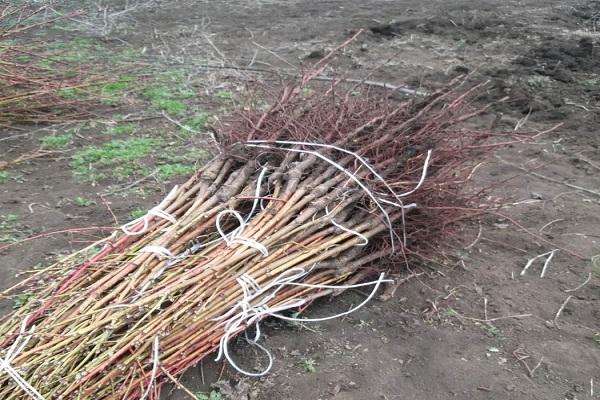
Seat preparation
The site for the peach Ambassador of Peace is picked up well-lit by the sun. If the place is shaded, the fruit will grow smaller than stated in the characteristic of the variety, and will also not be as sweet and aromatic. The peach will grow best on the south and southwest side of the plot. Fertilizer of the following composition is laid in the planting hole:
- 10 kilograms of rotted manure;
- 300 grams of wood ash;
- 50 grams of superphosphate and potassium chloride.
The fertilizer is mixed with the soil from the planting pit.
Important! Groundwater should not approach the soil surface closer than 1.5 meters.

Planting scheme and process
The Ambassador of Peace peach is planted as follows:
- A hole is dug 50-80 centimeters deep and wide.
- Drainage from sand, small stones, expanded clay is laid at the bottom.
- Then the prepared substrate is poured with a slide.
- Roots are laid out in the center of the slide, which are covered with the remaining soil.
- The peach circle is watered abundantly.
The near-trunk circle is mulched with sawdust or peat, the seedling is tied to a hammered peg.
Further care of the peach
Throughout the season, the peach is looked after: watered, fed, removed weeds around the tree, loosened the soil, and cut the crown if necessary.
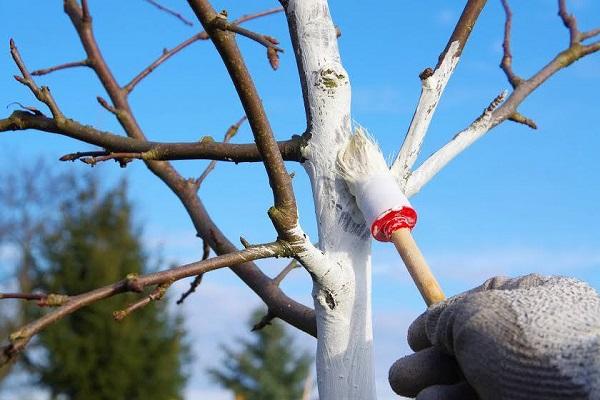
Watering mode
The Ambassador of Peace is a drought-resistant variety, but, nevertheless, it needs watering for full growth and fruiting. The earth is abundantly moistened when planting, then at the beginning of June. The main mass of peach roots is at a depth of 70 centimeters, so at least 20 liters of water is poured under each tree. During dry summers, the Ambassador of Peace is also irrigated in July and August.
Tree feeding
In the year of planting, the peach is not fed. He has enough fertilizers applied during planting. The next spring, furrows are made around the tree, and urea is introduced into them (50 grams per square meter). Before flowering, fertilizers are applied with a predominance of potassium. After fruiting, the soil is fed with a mixture of 40 grams of superphosphate and 50 grams of calcium chloride.

Pruning features
The crown of the peach is formed from the first years of his life. Cropping is necessary for the following reasons:
- more sunlight comes to the fruits, due to which they become sweeter and more aromatic;
- thinning the crown prevents the appearance of diseases;
- pruning regulates the abundance of fruiting and the convenience of harvesting.
The best pruning time is spring, budding period. It was at this time that you can see which branches wintered well, and which ones require removal. For the procedure, pruning shears, a hacksaw, and a garden knife are used. After cutting off the branches, the places of the cuts are sealed with garden pitch.
Wintering specifics
Peach Ambassador of Peace is a thermophilic culture. In autumn, trees are mulched with peat or compost to a height of 10-15 centimeters. In regions with a temperate climate, shelter will be required, especially for young seedlings. The structure is built from stakes driven into the ground and burlap wrapped around them. The twigs should be the same height as the tree.
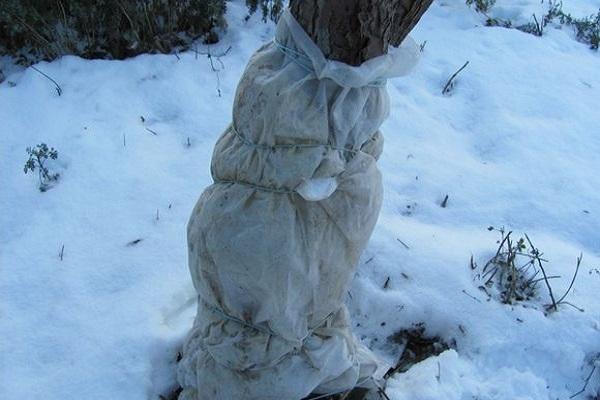
Instead of burlap, you can take cardboard and wrap it around the trunk. Several layers of non-woven material are wound on top.
In the southern regions, it is enough to sprinkle a peach with soil to a height of half a meter.
Peach protection from diseases and pests
The Ambassador of Peace is resistant to disease and pests. But due to improper care, he can be struck by some types of fungal diseases and harmful insects. This can happen due to the thickening of the crown, too frequent watering of trees, the presence of weeds in the trunk circle.
Observing agricultural techniques, the gardener will prevent the appearance of peach misfortunes. For prophylaxis, plants are sprayed in the spring, before bud break, with copper-containing preparations. In autumn, trees are treated with a solution of sulfur and lime, or insectofungicides.
Note! Correct implementation of agrotechnical techniques will prevent the appearance of most diseases and pests.
Harvesting and storage rules
Peaches are harvested when their color becomes deep yellow with bright carmine blotches on 80% of the fruit area. They do not ripen on the tree at the same time, so harvesting is done within several days. If the fruit is transported over long distances, it is harvested 5 days before it is fully ripe.
In room conditions, the fruits can be stored for 5 days. For long-term storage, they are placed in a refrigerator or basement. When keeping peaches in crates, each fruit is wrapped in paper. Fruits can be dried, frozen, as well as prepared from them compotes, juices, preserves, jams.

